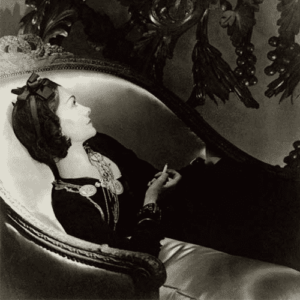
Photo Courtesy of Christie’s.
Gabrielle Bonheur ‘Coco’ Chanel’s inauspicious beginnings did not portend the impact she would have on the world of fashion. Her start in life was modest and at a young age, things took a turn for the worse when, upon her mother’s death, she and her sisters were sent the spend the remainder of their childhood in a convent orphanage. Learning to sew in the orphanage was probably the best thing to happen to young Coco. Her skills as a seamstress enabled her to earn a living while attempting to make her way as an actress. Designing hats at first then later branching out to clothing design, Coco turned what could have been time wasted in the rural pastimes of her lover into a notable career.
Fashion was changing rapidly and Coco adapted her designs to reflect the new silhouette emerging from the Belle Époque. Using jersey, a fabric heretofore reserved for creating undergarments, she created a T-shirt style top called a marinierés, a revolution in women’s fashion. According to the New York Times:
She induced members of her own sex to shorten their skirts, to bob their hair, to apply the jersey wool of their undergarments to afternoon dresses and to deck their persons with clusters of unabashedly fake jewelry.1
By the conclusion of the First World War, she had established herself and taken the world of couture by storm. The unexpected death of her patron and lover, Arthur Capel, threw Coco into a work frenzy.
Chanel dominated the Paris fashion world in the nineteen-twenties and at the height of her career was running four business enterprises – a fashion house, a textile business, perfume laboratories and a workshop for costume jewelry – that altogether employed 3,500 workers.2
Creating special jewelry to accompany her couture creations, Coco used a hands-on approach to design her jewels. The technique involved arranging stones like puzzle pieces and building clay models to support them forming bigger-than-life decorations for her sleek and tailored fashions. Inspiration for her jewelry came primarily from antiquity, the Egyptian age, Byzantine, Medieval, and Renaissance eras with bright colored gemstones and paste and intricate chains and findings. While her clothing designs were remarkable, the hoi polloi was not ready for her inventive mix of faux and natural jewels. At that time cabochon gemstones and “lesser” colored stones were not viewed as “real” jewelry but they were perfect for her over-the-top ideas. These fashion-forward big jewels established her.
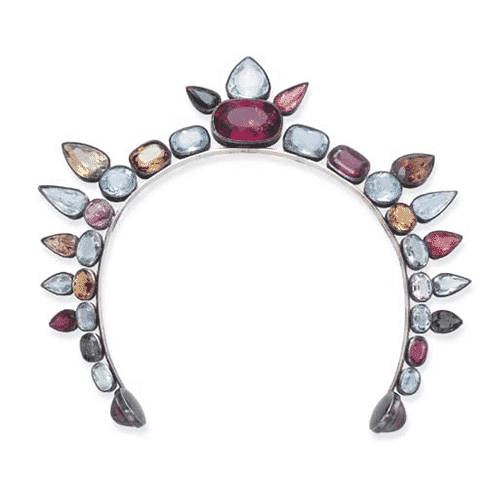
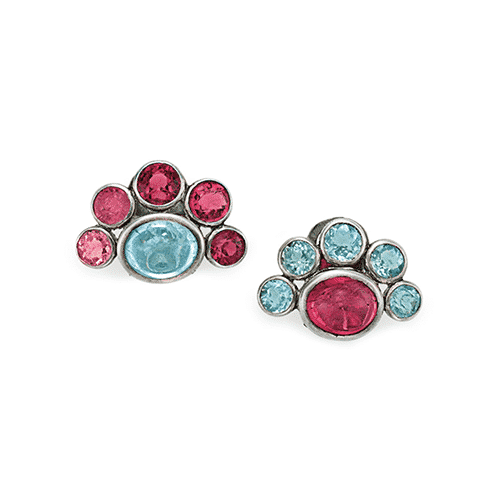
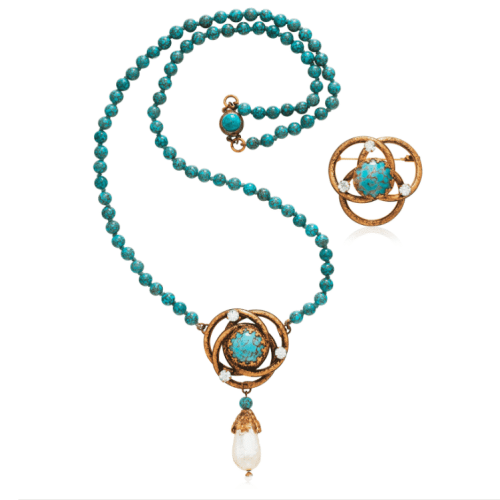
When the diamond market failed in 1932 The diamond industry attempted to re-establish their popularity by having Chanel create a series of 47 items of ‘Bijoux de Diamants’
If I have chosen diamonds, it is because they represent the greatest value in the smallest volume. And my love of things that glitter has inspired me to try to combine elegance and fashion through the medium of jewelry.3
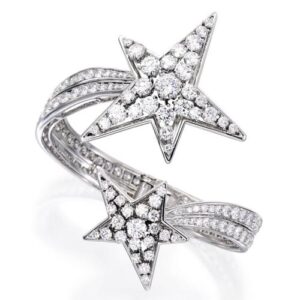
Photo Courtesy of Sotheby’s
The result was to shift diamond jewelry from the purview of the wealthy and make them a fashion item. Each jewel was designed to be convertible having more than one purpose and was composed with invisible clasps and settings. The featured motifs were comprised of variations on bows, stars, and feathers. Equally as unexpected as the actual jewelry designs were the mannequins employed to display this unusual collection. None of this was lost on the conventional jewelers of the time and the choice of a “dressmaker” over the jewelers of Place Vendome angered the established jewelry houses. They attempted to block the sale of these creations and have them all dismantled, only a few pieces are known to have escaped their wrath.
Chanel moved within a circle of some of the most interesting figures of her time. Paul Iribe, Etienne de Beaumont, Jean Cocteau, Pablo Picasso, and Fulco Verdura to name a few. While they all influenced her jewelry designs on some level, Verdura’s designs for Chanel encompassed an intimate knowledge of art history and demonstrated a strong sense of classical design. The wide enamel and gem set Maltese cross motif bracelet is probably the most memorable design to arise from their collaboration. Their association ended in 1934 when Verdura moved to New York, eventually designing for Paul Flato and, in 1937, opening Flato’s Los Angeles location. The people who had an impact on Chanel’s designs came and went but one constant in her jewelry line was the use of the Gripoix workshop in Paris to manufacture her costume jewelry.
The declaration of war between France and Germany at the start of World War II resulted in the closing of all but one of her boutiques – Paris. Choosing to live out her days in Switzerland, Coco went into temporary retirement, reemerging in the 1950s to create her antidote to the “new look.” In 1971 at the age of 87, she died “with her boots on” creating and designing until the very end.
Maker's Marks & Timeline
Specialties
1883
- Gabrielle Chanel born in Saumur, France.
1910
- Chanel Opens her First Shop at 21 Rue Cambon, Paris
1913
- The Deauville France Boutique Opens and She Begins to sell Sportswear and Jersey Garments.
1915
- The First Couture Chanel House Opens in Biarritz, France.
1918
- The Couture House at 31 Rue Cambon, Paris Opens.
1921
- Chanel No.5 Became the First Couture Perfume.
1927-1933
- Verdura Collaborates with Chanel on Jewelry Design.
- First Line of MakeUp c.1924
1930
- Maltese Cross Design
1932
- Bijoux De Diamants
1939-1945
- Closed During the Occupation
1954
- Re-Opening of Chanel Couture House
1971
- Death of Coco Chanel
Sources
- Bennett, David & Mascetti, Daniela. Understanding Jewellery: Woodbridge, Suffolk, England: Antique Collectors’ Club, 2008.
- Mauriès, Patrick. Jewelry by Chanel. Boston: Little, Brown and Company,1993.
- Weir-de La Rochefoucauld, Juliet. Women Jewellery Designers, Suffolk: ACC Art Books, 2017.
- “Portrait of a Designer: ‘Coco’ Chanel.” New York Times July 29, 1961: p.7. Print.
- “Chanel, the Couturier, Dead in Paris.” New York Times January 11, 1971: p. 1, 35. Print.

